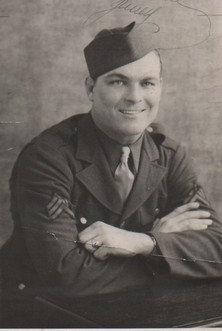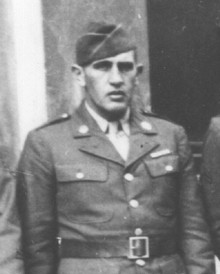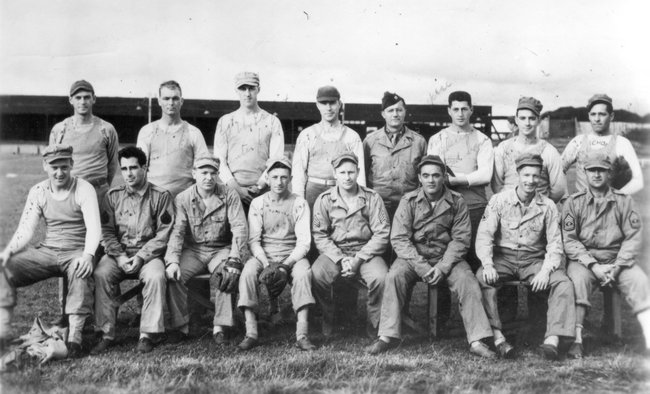The Bedford Ballplayers
by Gary Bedingfield
In the 1930s, Bedford –
with a population of 3,200 - was a small, rural town at the heart of rolling
hills and lush valleys near Virginia’s
Blue Ridge Mountains. For the young men of this tight-knit
community, the Depression years offered little in the way of prospects, and
baseball helped wile away the summer hours and conjure up images of playing
on major league teams. Baseball was truly the national pastime back then and
for two young men – Frank Draper and Elmer Wright - it would weave an
integral thread through their tragically short lives.
 |
| Frank Draper |
"When we were growing up in Bedford," recalls Frank’s brother, David Draper,
"There wasn't much going on here for young people, so from a young age
[Frank] was always playing sports in and around Bedford. That's how he
became such a good athlete.
Frank Draper was tall, lean and
fast. He played baseball for Mud Alley - a tough
neighborhood team and starred with
Bedford
High School. After
graduation, he went to work at Hampton Looms, the town’s largest employer,
and became the centerfielder and leadoff hitter with the company’s baseball
team. Batting two and three for the team were his brothers, David and Gamiel.
Meanwhile, Elmer Wright - the son of Bedford's deputy sheriff – was also establishing himself as
a standout athlete at Bedford
High School. A hard
throwing right-handed pitcher, Wright hurled for a number of local semi-pro
teams before signing a professional contract with the St Louis Browns in
1937.
Wright was assigned to the Terre Haute Tots of
the Three-I League his rookie year where he won 10, lost 13, and finished
the season with the Kitty League's Mayfield Clothiers. He began the 1938
season with the San Antonio Missions in the Texas League, and spent time at Palestine and
Johnstown.
Wright was back with San Antonio
for 1939, and posted a 10-9 won-loss record that year and was 10-5 in 1940.
He was due to attend spring training with the St Louis Browns in 1941.
About 30 miles away in Roanoke, Virginia, a young catcher named Robert Marsico was making
a name for himself on the
Gilmer
High School baseball team.
After graduating, he got a job with the Frank E Brown company treating
cowhides, and later helped build the Blue Hills golf course in
Roanoke
before landing a job with the Piedmont Label Company in Bedford. It wasn’t long before Marsico was the
starting catcher on the Piedmont Label baseball team.
Like many local youngsters, Draper, Wright and
Marsico had joined Company A of the National Guard enticed, perhaps, by the
promise of a dollar every Monday night after marching practice at the
Bedford Armory. But as the war in Europe took hold and the
United States began to expand its fighting forces, it
was announced in October 1940, that
Bedford's Company A would be mobilized into the
Federal Army for a period of one year.
 |
| Elmer Wright |
Four months later, on
February 3, 1941, the three young ballplayers, along with six officers and
89 other enlisted men of Company A, reported to the Bedford Armory where
they were issued new uniforms and took the oath of transfer and allegiance.
They were sent to Fort Meade,
Maryland, home of the 29th
Infantry Division, and between training, they regularly played for the Fort
Meade
baseball team.
It was while returning to Fort Meade
from military exercises in North Carolina
that news of the Japanese attack on Pearl Harbor
reached the boys of Company A. For Draper, Wright and Marsico it meant there
was no way they would be home in a year. They were now soldiers in Uncle
Sam’s army for the duration.
In August 1942, the 29th
Infantry Division left Fort Meade bound for Camp
Blanding in Florida. Less than a month later, they were
preparing to move out although they had no idea where they were going. It
might be the Pacific to fight the Japanese, or Europe
to take on the Germans and Italians.
The
question was soon answered. The 29th
boarded a train that took them to Camp Kilmer,
New Jersey - staging post to Britain. A
staggering 11,000 troops boarded the
Queen Mary
for the Atlantic crossing with an escort of five destroyers and a British
cruiser,
HMS Curacao.
As the
Queen Mary
approached Scotland, the
Curacao guided her to the Forth of Clyde. It was a routine
operation but at 2.12pm on October 2, 1942 disaster struck. The
Queen Mary collided with the
Curacao. The huge ocean liner suffered minimal damage
but the
Curacao
sank almost immediately from the impact. Three hundred and thirty-eight
British lives were lost.
 |
| Robert Marsico |
Shaken, but safely on dry land in Scotland, the division moved by train to London, England
and from there to Tidworth Barracks just ten miles from historic Stonehenge. It was the beginning of an intensive training
program that would last until May 1944 - the longest of any US infantrymen in World War II.
Nevertheless, Draper, Wright and Marsico still found a little time for
baseball. In September 1943, they played for the 116th
Infantry Regiment Yankees in a four-day US
services baseball tournament in
London. The 116th
were a dark horse team at the outset - unknown to most of the other teams
who were already playing in well-established military leagues around
Britain. The
Bedford
boys were the backbone of the team. Draper’s hitting, Wright's pitching and
Marsico’s defensive work behind the plate guided the Yankees to an
unexpected place in the final against the Eighth Air Force Fighter Command
Thunderbolts that saw the 116th
win 6-3 for the ETO championship title.
That was their last chance to play any form of competitive baseball. For the
remainder of 1943 and the first five months of 1944 the order of the day was
intensive military training in preparation for the invasion of mainland
Europe. Wright, however, still found time to keep in touch with
the St Louis Browns. “You certainly have spent quite a long stretch in the
Army,” wrote Browns’ Vice-President William O DeWitt in reply to Elmer
Wright’s letter on March 16, 1944, “and if the newspaper stories are
correct, perhaps you will get a chance to return to this country in the not
too distant future.”
 |
| 116th Infantry Regiment Yankees |
On May 18, 1944, the 29th
Infantry Division was taken in trucks to containment camps on the southeast
coast of England. The countdown to D-Day had
begun. Movement outside the camps was strictly forbidden as absolute secrecy
regarding invasion details was essential and it was a boring and anxious
couple of weeks for the men of Company A. "Whenever we had time, I put on a
glove and [Elmer Wright] pitched to me," recalled former college catcher,
Hal Baumgarten in Alex Kershaw's
The Bedford Boys.
"Wright was fast. I had to put a double sponge in the glove."
On the morning of June 6, 1944, Technical-Sergeant Frank Draper,
Staff-Sergeant Elmer Wright and Private Robert Marsico were on landing
crafts heading for Omaha Beach
at Normandy.
Company A of the 116th
Infantry Regiment was to lead the D-Day assault. As the landing crafts
approached the beach, the enemy opened
fire
with artillery, mortar, machine-gun and small arms fire. Draper's craft
shook with the horrifying impact of an anti-personnel shell that ripped
through the side of the vessel and tore off his upper arm. Rapidly losing
blood, the young soldier slumped to the floor.
Bedford’s fleet-footed outfielder died soon
afterwards in a pool of blood, seawater and vomit.
Wright and Marsico’s landing craft made it to the
beach. As the ramps dropped down the men of Company A were met with a hail
of deadly accurate enemy fire. Many were killed outright; others lay
critically wounded, screaming for help. Those that could jumped in to the
six-foot of water and desperately tried to make their way to the beach.
Hal Baumgarten, the young receiver who had played
catch with Elmer just days before, made it to the beach but an exploding
artillery shell shattered his jaw. As he slumped to the ground, he looked to
one side and there was the dead body of Elmer Wright. “I was certain it was
him because of his nose,” he recalled. “It was just like Dick Tracy’s in the
cartoon.”
Marsico suffered injuries to his right arm and
leg in the chaos and carnage. He somehow survived the killing zone, but his
injuries ensured he would never play baseball again.
The small community of Bedford had suffered badly. It was not until
July 16, 1944 that news of the horrendous losses suffered on D-Day reached
the townsfolk of Bedford, Virginia. Nineteen of the 34 Bedford boys of Company A died in the first bloody minutes
at Omaha Beach. Two more died later in the day. Bedford suffered higher
losses per-capita than any other American community in World War II.
In 1947, Frank Draper's body was returned to Bedford and now rests at Greenwood Cemetery.
Elmer Wright is buried at the Normandy
American
Cemetery
at Colleville-sur-Mer in
France. Robert Marsico went back to work at
the Piedmont Label Company, and although he was unable to play baseball he
enjoyed a round of golf and won a number of local tournaments. He passed
away peacefully at his home in Bedford in August 1986.
 |
|
Elmer Wright, Robert Marsico, Pride Wingfield (also from Bedford, VA) and
Frank Draper
|







